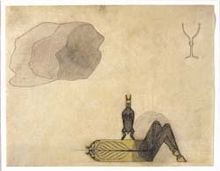August Natterer
August Natterer | |
|---|---|
| Born | 3 August 1868 |
| Died | 7 October 1933 (aged 65) |
| Occupation(s) | Artist, electrician |
August Natterer (3 August 1868 – 7 October 1933), also known as Neter, was a German outsider artist with schizophrenia.


Biography
August Natterer, given the pseudonym Neter by his psychiatrist to protect him and his family from the intense social stigma associated with mental illness at the time, was born on 3 August 1868 in Schornreute, a quarter of Ravensburg, Germany, the son of a clerk and the youngest of nine children. Natterer studied engineering, got married, travelled widely and had a successful career as an electrician, but was suddenly stricken with delusions and anxiety attacks.[1] On 1 April 1907, he had a pivotal hallucination of the Last Judgment during which "10,000 images flashed by in half an hour".[2] He described it as follows:
I saw a white spot in the clouds absolutely close – all the clouds paused – then the white spot departed and stood all the time like a board in the sky. On the same board or the screen or stage now images as quick as a flash followed each other, about 10,000 in half an hour… God himself occurred, the witch, who created the world – in between worldly visions: images of war, continents, memorials, castles, beautiful castles, just the glory of the world – but all of this to see in supernal images. They were at least twenty meters big, clear to observe, almost without color like photographs… The images were epiphanies of the Last Judgment. Christ couldn't fulfill the salvation because he was crucified early... God revealed them to me to accomplish the salvation.[3]
This ordeal led to a suicide attempt and committal to the first of what would be several mental asylums occupied during the remaining twenty-six years of his life. Natterer thereafter maintained that he was the illegitimate child of Emperor Napoleon I and "Redeemer of the World". The vision had inspired an intense production of drawings, all documenting images and ideas seen in the vision.
August Natterer died of heart failure in an institution near Rottweil in 1933.[4]
Artistic works

Natterer was one of the "schizophrenic masters" profiled by Hans Prinzhorn in his field-defining work Artistry of the Mentally Ill.[5] His drawings are attempts to capture the "10,000 images" of his April 1st hallucination, and are always rendered in a clear, objective style, like that of a technical drawing. This may be due to his background as an electrician.
Natterer once claimed that Axle of the World, with Rabbit had predicted World War I. The rabbit represented "the uncertainty of good fortune. It began to run on the roller... the rabbit was then changed into a zebra (upper part striped) and then into a donkey (donkey's head) made of glass. A napkin was hung on the donkey; it was shaved".[6]
Max Ernst's Oedipus Rex was influenced by Natterer's piece Miraculous Shepherd.[7]
See also
References
- ^ Röske, Thomas. "August Natterer". Raw Vision Magazine. No. 51. Archived from the original on 20 November 2012. Retrieved 2 June 2015.
- ^ Bottoms, Greg (2011). The Colorful Apocalypse: Journeys in Outsider Art. ReadHowYouWant.com. p. 74. ISBN 978-1-4596-1432-1.
- ^ Duponis janine dupont arts court at duponis.com Archived 5 April 2005 at the Wayback Machine at www.duponis.com
- ^ "August Natterer, 1868–1933 – UK Disability History Month". September 2017. Archived from the original on 2 January 2020. Retrieved 2 January 2020.
- ^ Katharine Conley; Pierre Taminiaux (2006). Surrealism and Its Others. Yale University Press. p. 132. ISBN 978-0-300-11072-2.
- ^ Prinzhorn, Hans. (1972). Artistry of the Mentally Ill: a contribution to the psychology and psychopathology of configuration. Translated by Eric von Brockdorff. New York: Springer-Verlag. p. 168. ISBN 3-540-05508-8.
- ^ "Framing Marginalised Art By Karen Jones, Eugen Koh, Nurin Veis, Anthony White, Rosalind Hurworth, Johanna Bell, Brad Shrimpton, Anthony Fitzpatrick, p.19". Archived from the original on 9 October 2023. Retrieved 28 March 2023.
External links
 Media related to August Natterer at Wikimedia Commons
Media related to August Natterer at Wikimedia Commons
- Webarchive template wayback links
- Articles with short description
- Short description is different from Wikidata
- Use dmy dates from May 2022
- Articles with hCards
- Commons category link from Wikidata
- Articles with FAST identifiers
- Articles with ISNI identifiers
- Articles with VIAF identifiers
- Articles with WorldCat Entities identifiers
- Articles with GND identifiers
- Articles with LCCN identifiers
- Articles with MusicBrainz identifiers
- Articles with ULAN identifiers
- Articles with DTBIO identifiers
- Articles with SUDOC identifiers
- Outsider artists
- 1868 births
- 1933 deaths
- 19th-century German painters
- German male painters
- 20th-century German painters
- 20th-century German male artists
- People with schizophrenia
- 19th-century German male artists